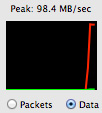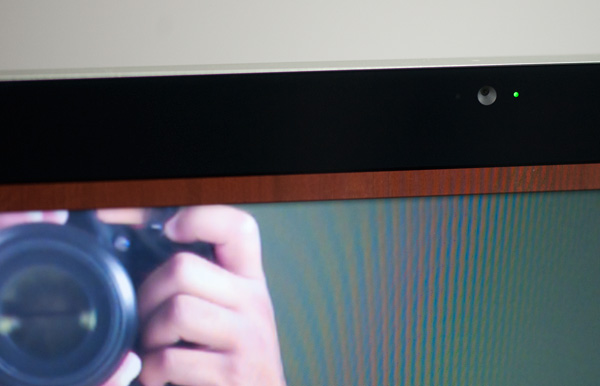The Apple Thunderbolt Display Review
by Anand Lal Shimpi on September 23, 2011 2:56 AM EST- Posted in
- Displays
- Mac
- Apple
- Thunderbolt
- Thunderbolt Display
Testing the Pieces
Before we get to the display and Thunderbolt specific testing I wanted to confirm that the individual controllers in the Thunderbolt Display were just as capable as those in the Mac it was connected to. For the most part, they are.
Following in Brian Klug's footsteps, I created two RAM disks - one on a MacBook Air and one on a MacBook Pro. I connected both systems to my local GigE network and copied giant files between them. I measured over 780Mbps going from the MacBook Air to the MacBook Pro, and 832Mbps in the other direction (images below). That's about as good as it's going to get.
 |
 |
Next I tested performance over FireWire 800 and USB 2.0. For FireWire 800 I used a Western Digital My Book Studio Edition II configured in RAID-1 and measured peak read speed from the device. For USB testing I turned to a Corsair Flash Voyager 3.0 (USB stick) and a SF-2281 SSD connected to a SATA-to-USB bridge. In both of the USB tests I measured write speed to the USB 2.0 devices. Apple appears to have chosen its FireWire controller well as performance was only off by 2MB/s compared to the FW800 port on the 15-inch MacBook Pro. USB 2.0 performance wasn't nearly as good however, I maxed out at 16.4MB/s and saw typical rates closer to 15MB/s:
| Transfer Rate Comparison | |||||
| FireWire 800 | USB 2.0 (stick) | USB 2.0 (SSD) | |||
| Apple Thunderbolt Display | 70.0 MB/s | 14.1 MB/s | 16.4 MB/s | ||
| Apple 15-inch MacBook Pro (2011) | 72.0 MB/s | 21.2 MB/s | 32.2 MB/s | ||
Both the audio controller and FaceTime HD cameras interface via the Thunderbolt Display's internal USB controller. It's likely that one of those devices is forcing the controller to negotiate at a lower speed and thus ultimately limit peak USB 2.0 performance through the display. Note the gap in performance is much smaller if you're looking at transfers to a USB stick vs. an SSD. I happen to have a lot of SSDs around so I tend to use them as glorified USB sticks, I suspect the majority of users won't notice much of a difference due to the lower overall performance of standard USB sticks.
FaceTime HD Camera
Although Photo Booth in Lion captures at 1080 x 720, using iSightcapture I was able to confirm that the sensor in the Thunderbolt Display appears to be able to capture 1280 x 720 natively. Quality is what we'd come to expect from the current generation of FaceTime HD cameras.
I tested the camera both in Photo Booth and in a FaceTime chat with our own Brian Klug. The experience worked fine in both cases.

FaceTime seems to have issues when one party is in a noisy environment but that doesn't appear to have anything to do with the Thunderbolt Display hardware as I duplicated the issue on a MacBook Air as well. If you're curious, the problem I'm talking about occurs when the party in a quiet environment is trying to talk to the person with a lot of background noise. The quiet party will hear audio just fine but the noisy party will get a lot of broken up audio from the other side. It seems like FaceTime is trying to do some active noise cancelation that ends up doing more harm than good. I confirmed it's a FaceTime software problem by calling Brian via Skype without any issues.











275 Comments
View All Comments
MobiusStrip - Friday, September 23, 2011 - link
I wish someone would have the balls to step up and end this moronic glossy-screen fad.Glossy sucks in all lighting conditions. It doesn't matter where the illumination is coming from in the room, or even if there IS any. At the very least, the light from the monitor is going to illuminate YOU, putting your reflection over those supposedly "deep blacks" and "rich colors." Glossy screens work for one customer: the ninja in the closet.
Going from a glossy screen to matte is like cleaning a filthy windshield: You wonder how you put up with it until that moment.
retrospooty - Friday, September 23, 2011 - link
"Glossy screens work for one customer: the ninja in the closet."At the risk of outing my secret identity, we closet Ninja's reject your claim!
Colorblinded - Friday, September 23, 2011 - link
You and me both. I can tolerate it on my phone but my desktop or laptop are matte only.HMTK - Friday, September 23, 2011 - link
++That and widescreen resolutions. Gimme a 4:3 high res matte screen anyday!
Constructor - Friday, September 23, 2011 - link
Well, 16:9 with a 2560-pixel display still gives me 1440 pixels vertically, surpassed only by the 1600 in a 16:10 30" panel which costs double the price and significantly more than in any of the smaller resolutions.So I can live quite comfortably with my iMac 27" (same panel as in the TBD). "Suffering" on a very high level, so to speak. 8-)
doubledeej - Sunday, September 25, 2011 - link
I've always felt like integrated monitors are a waste. The trouble with iMacs (and all All-in-Ones) is that you have to buy your monitor over and over again each time you buy a computer. So ~$800 of your computer's price went toward getting that 27" monitor, and when your computer dies, so does your display, and that money is lost.I've been using the same four high-end LCDs for my last three computers. I'll gladly spend $500/yr to ensure I have the latest and greatest computer without having to invest an additional dime in new displays.
Constructor - Sunday, September 25, 2011 - link
Macs generally life for many years. Actually, none of mine has ever "died". Even my first one from the early 1990s still works as on the first day.Plus, recent iMacs can serve as external monitors for other computers.
Maybe you're just switching your computers a little frantically compared to most other people. My Macs have so far been in productive use for 5-6 years each and are just mostly collecting dust since retirement because I chose not to sell them to someone who could get good use out of them even after that.
This is my first iMac. I'll see whether I'll keep it around as a monitor for its successor or if I'll just sell it off when the time comes. It's a pretty good concept, however, and it works very well in practice.
jecs - Friday, September 23, 2011 - link
I am stepping up (balls?) but to say you think you know what you are talking about but you are not.The thunderbolt display is a high end consumer display not a professional level display.
Even the Dell 2711 is an entry professional monitor. Dell Is better suited for color correction and wide color gamut space but not the real broadcast deal.
Where, where in a broadcast professional production environment would you even consider an Apple display? Maybe on press production for everyday news or on production studios for independent production on constrained budgets who don't depend on critical wide color gamut.
80% of consumers and most professional not working on critical color correction don't care for mate screens. Glossy screens are better for watching a movie or content and in a controlled environment this is acceptable.
name99 - Friday, September 23, 2011 - link
"The thunderbolt display is a high end consumer display not a professional level display.""Where, where in a broadcast professional production environment would you even consider an Apple display?"
If only there were professions OTHER than "broadcast professional"...
But sadly we live in a world where every professional is a broadcast professional, and clearly Apple has screwed up in making a device that appeals to print workers, or programmers, or musicians. None of them, after all, are professionals...
jecs - Saturday, September 24, 2011 - link
80% of people buying from Apple opted for glossy screens, this is a fact. The 20% that opted for mate screens still have the "optional antiglare display" in 15-17 Mac book Pros.Now, photographers, programers, musicians or other professional working with a "Mac Pro" have great options from other very well recognized vendors like LaCie, NEC, EIZO, HP, Dell and others.
Apple as well as Dell have always been a cheap competitive alternative for higher end displays but never the best dedicated option for professionals who depend on the most accurate screen.
The only ones abandoned are the casual, or entry level professionals that got use to working with Apple displays and some high end aficionados. That is true, but those could buy today a LaCie Monitor for around $950.
I don't know, Apple could launch a mate display line whenever they see the opportunity, but they appear not seeing a good one in the present. Maybe they don't consider the number of professionals buying from Apple enough to produce more mate displays.
Cheer up!